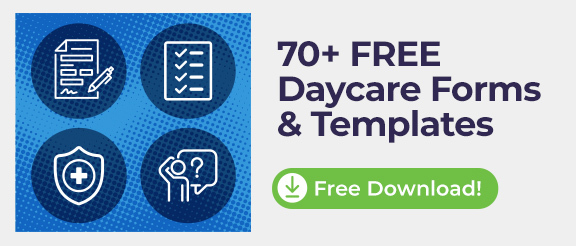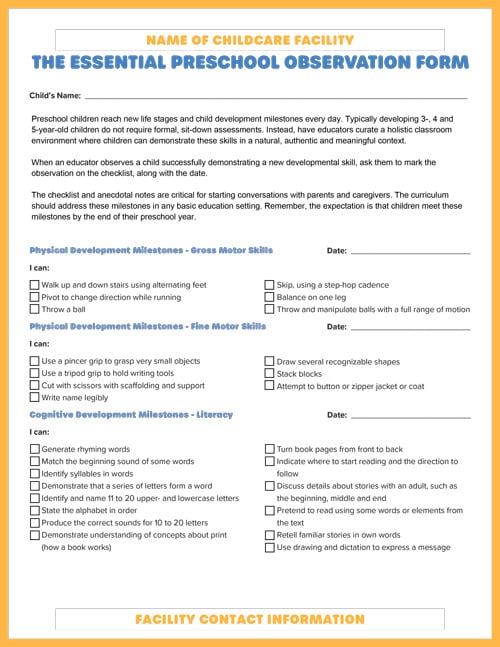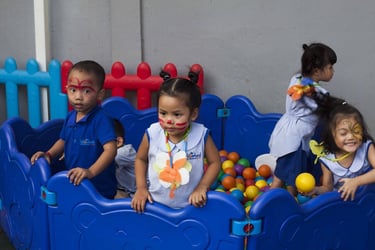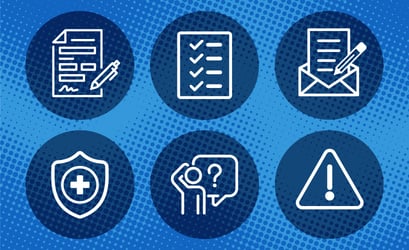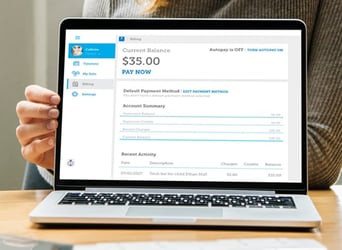A preschool observation form is an important tool in any child care setting. These forms and the observation process help teachers and other center staff focus on individual children. Observers look for growth and development milestones, which can be used for progress discussions with parents and teacher feedback, and to reinforce or adjust learning plans to meet each child’s needs.
This guide includes details on when and how to conduct a preschool observation and provides sample language for behavior observation forms for preschool. It also describes how to use anecdotal observations as part of each child’s preschool record. Read on to learn how to manage this vital process in your preschool setting.
Table of Contents
- When to Do a Preschool Observation in Your Child care Center
- How Should You Conduct Your Observation?
- What Should You Do With Your Preschool Observation Form?
- Free Preschool Observation Form Template
- Anecdotal Records for Preschool Institutions
When to Do a Preschool Observation in Your Child care Center
Administrators can choose how frequently to conduct student observations; however, it's best to do this at regular intervals.
For example, you may conduct observations every six weeks. Alternatively, perhaps you'd prefer to conduct them quarterly or twice a year.
The number of classes in your center and the volume of students may determine how often you conduct observations. However, performing them at regular intervals allows you to note any changes and developments in a child's:
- Physical growth
- Dexterity
- Social habits
- Behavior
If you're unsure how to conduct an observation, continue to the next section.
How Should You Conduct Your Observation?
First, prepare your behavior observation form for preschool. You can find resources to help prepare these documents online.
Then, find a discreet spot in the back of the classroom where you can comfortably observe the teacher and students. If any children ask what you're doing, give them a vague but truthful answer. It can be as simple as saying that you're writing.
Next, keep an objective record of each child's behavior. For example, instead of saying, "Mary is pestering Lila during play," record the exact exchange.
Another thing to note is what sort of feedback children receive in the classroom. Is it a mix of positive and negative feedback? Or does the teacher provide overwhelmingly positive or negative feedback?
As you observe children, make sure you note the following:
- Physical and motor development
- Social and emotional development
- Behavior with other children and adults
- Intellectual development
Also, note the differences between children’s development. Some students may have better-developed social skills. Others may have better motor skills.
These differences can provide vital information about your students. Also, consider how students interact with adults.
Do some children seem particularly attached to any adult? Do they interact more confidently with adults than with children?
You can also use these times to make observations about your preschool staff. What do teachers seem skilled at doing in class? What could use improvement?
What Should You Do With Your Preschool Observation Form?
Once you complete your behavior observation form for preschool, you can do a few things with it. First, keep a record of it so you can compare this observation with future ones.
Next, you can use the forms as progress reports. You can share your observations with teachers and compare notes with them. For example, you may ask the teacher for additional information about a student.
Additionally, these reports can provide constructive criticism for your staff. While you should always recognize your teachers' skills, these observations can point out any weaknesses in their methods. This feedback can help teachers improve.
You can also use these reports to update parents about their children's development. Providing detailed information about each child's development can help parents consider additional steps they can take to foster growth at home.
Free Preschool Observation Form Template
When caring for small children, the small details are really the biggest details.
Preschool-aged children are dynamic individuals who grow and change by the day. Your careful, competent staff are lucky enough to observe and document their exciting developmental milestones as they happen. That's why great preschool classrooms use a simple, detailed preschool observation form and checklist as part of their daily practice.
If you haven't implemented this simple assessment format at your center, your staff is missing out on a dynamic opportunity to deeply understand the children in their care.
Below, we've provided a comprehensive early childhood development checklist for use in your 3-, 4- and 5-year-old classrooms. When used daily, this form can become a foundational component of your early childhood assessments. Ask your staff to carry this checklist on a clipboard to document children's evolving skills as they go about their day.
Download the Free Preschool Observation Form
Anecdotal Records for Preschool Institutions
Sometimes, tracking preschool milestones involves more than checking ”yes” or “no.” In those instances, care providers take anecdotal notes. These unbiased, objective qualitative reports describe academic skills and behavior in more detail. Anecdotal records are especially helpful if a child is struggling or may need special education services.
Consider taking anecdotal notes for each child during these times of day:
- Large group instruction, morning meeting or circle time
- Small group instruction
- Academic choice time
- Free play
- Outdoor play
- Indoor gross motor play
Ideally, caregivers will observe children demonstrating (or attempting to demonstrate) milestones from each developmental domain on the checklist. Sometimes the best place to observe skills in action is the playground.
Writing an Observation Record
Use these questions to guide you as you construct your narrative.
- What exactly do you see? Include facial expressions, gestures, etc.
- What exactly do you hear? Record any dialogue pertinent to social, emotional or language development.
- Where in the classroom does the observation take place? Note when a child moves from one area to another.
- What time does the observation take place? What came immediately before?
- Are there any other children involved in the interaction? You may want to denote them using a first initial.
- How long did the child engage in each component of the behavior or activity?
- How old is the child at the time of observation in chronological age?
Analyzing an Observation Record
Once you record your objective and unbiased account of events, it's appropriate to interpret the data. Use these questions to guide you as you analyze your record.
- Can you make any inferences from your observation?
- Which specific milestones from the checklist did the child demonstrate during this observation?
- What specific milestones from the checklist is this child working toward? How do you know?
- How can you use this data to inform your future planning in the classroom?
When sharing anecdotal records with parents, share only the information from the preschool observation form, not the analysis. Instead, discuss your inferences and next steps verbally.
Get 70+ Editable Daycare Templates for Almost Every Situation
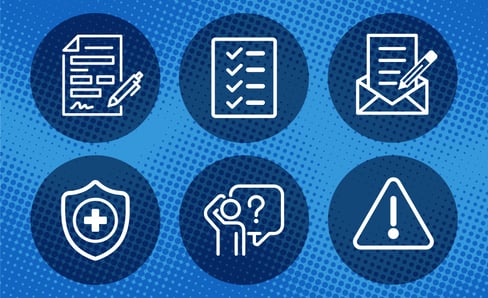 We know daycare providers like yourself are busy. That's why we made dozens of templates to help you manage the various aspects of your organization. From billing and invoicing to marketing materials, we have it all. Download all 70 today!
We know daycare providers like yourself are busy. That's why we made dozens of templates to help you manage the various aspects of your organization. From billing and invoicing to marketing materials, we have it all. Download all 70 today!




